Knife scout HP-43 "Cherry": a historical mystery
According to the most common and well-known version, the knife HP-43 was created during World War II as a replacement for the existing sample. Since 1940, the Red Army has been equipped with a NA-40 opener (the alternative designation of HP-40 is also found), created taking into account the operating experience of other similar weapons. ON-40 managed to establish itself as a military weapon and an economic tool. At the same time, there were some shortcomings that should be corrected in new projects. In particular, the specific shape of the knife cross, calculated for use in battle, made it difficult to cut various objects and materials with a straight grip.
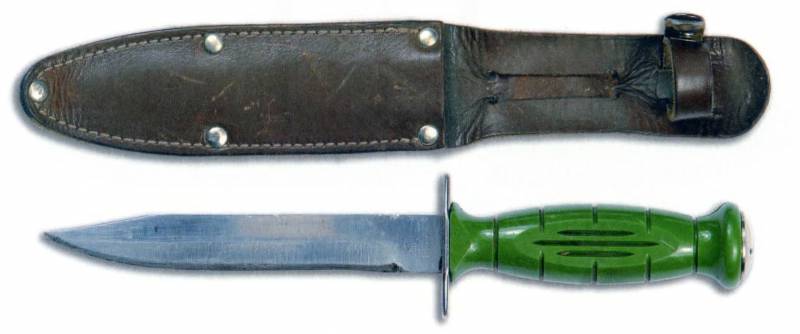
Product HP-43 and its sheath. Photo Marianko A.A., Mack A.A. "Army short blade of the 20th century: on earth, in the heavens and at sea"
In 1943, a new army knife called HP-43 was adopted. “Knife scout arr. 1943 G. ”was a modified and improved version of the existing ON-40. The design of some parts was revised, and a completely new handle of non-standard material appeared. At the same time, however, the blade remained the same, only its shank, which is necessary for connection with the handle, has changed. In this form, the weapon went into series and soon became the regular armament of various military units, primarily, as its name suggests, reconnaissance.
Over time, the knife was called "Cherry". It is believed that this name appeared because of the peculiarities of the stamp put on the product. The stylized handwritten letter “P” on the stamp resembled the peasant fruit of a common tree. Such a similarity, noticed by unknown knife operators, has led to the appearance of an unofficial nickname. To date, the simple nickname of the knife has become a real brand.
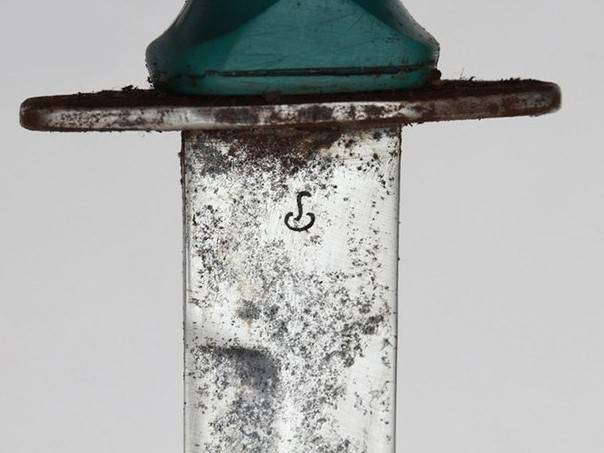
Stamp "P" on the blade, which became the reason for the appearance of the name "Cherry". Photo Guns.allzip.org
According to a number of sources, the HP-43 knife remained in service with the Soviet army until the sixties, after which, along with other similar products, it gave up its place to regular bayonet knives of machine guns. Special units of the army and security forces, however, did not abandon such weapons and continued to use them until the nineties. It is alleged that some fighters of individual structures, as well as a number of foreign units, are still using HP-43 and so far do not intend to abandon it.
In recent decades, the 1943 model knife of the year has become known to the general public. Lucky collectors managed to get the original knife, released for the Soviet armed forces, and for all the others, several companies started producing exact replicas of the product. To date, the knife HP-43 "Cherry" has become an integral part of the history of domestic cold weapons, of great interest to all interested in this subject.
The “classic” design of the HP-43 knife is as follows. The product retains the knife blade ON-40 with a length of about 150 mm, width 22 mm and thickness 2,6 mm. The blade has a one-sided sharpening and bevel oblique ("pike"). Blades bevels occupy at least half the width. Sharpening the blade leaves a small heel near the cross. In connection with the new method of mounting the blade in the handle, the shank underwent some changes: a short cylindrical protrusion with a thread appeared on it. In the heel area, the marks of the manufacturer were applied to the blade.
The most recognizable feature of the knife "Cherry" is the handle of the new design. Instead of the “anatomical” wooden one used on NA-40, a symmetrical plastic was used with a thickening in the central part reducing the thickness in the direction of the cross and the top. For convenient retention on the handle, five transverse grooves covering the part were provided, as well as cut flat side sections with three horizontal grooves. Inside the handle there was a channel to install the shank. The fixing of the latter was carried out with the help of a nut-pommel with a large cap having a flat slot. The “classic” look of the HP-43 implies the use of green plastic, but there are also products with black trim.
Unlike the HP-40, Cherry received a straight cross with a simple design. To protect the hand, a flat piece of small thickness is used, having triangular protrusions with rounded tops. The bending of the cross to the handle or the blade is not provided.
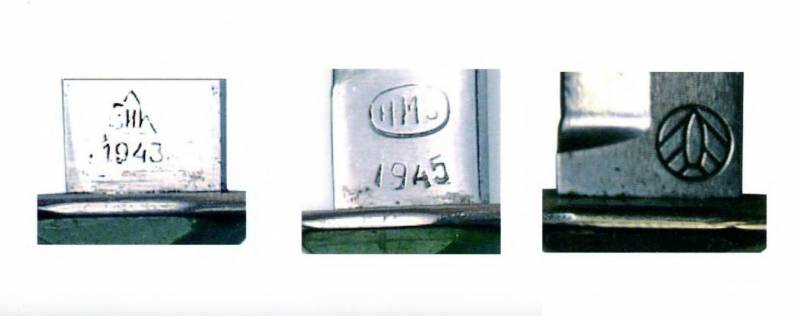
Various stamps found on the Cherry blades. Photo Marianko A.A., Mack A.A. "Army short blade of the 20th century: on earth, in the heavens and at sea"
The knife was completed with leather sheath, consisting of several parts. To store the blade, a device was used consisting of two leather parts connected with rivets. The enlarged leather band had holes for hanging the scabbard on the belt, as well as slots for installing the fixing strap. The latter should have covered the handle and not let the knife fall out.
The total length of the HP-43 knife was approximately 260 mm with a blade length of about 150 mm. Product weight - about 150 g.
According to the well-known version of the origin of the knife, the first serial HP-43 were released by the Zlatoust tool factory-combine them. IN AND. Lenin ("ZIK"). However, no valid evidence of this was missing. Moreover, the early history of the knife was based only on a few photographs and statements, not supported by facts. These circumstances forced the specialists of the Zlatoust weapons factory (as the former tool factory is now called) to sort out the situation and find out the true history of the weapons allegedly produced by their enterprise.
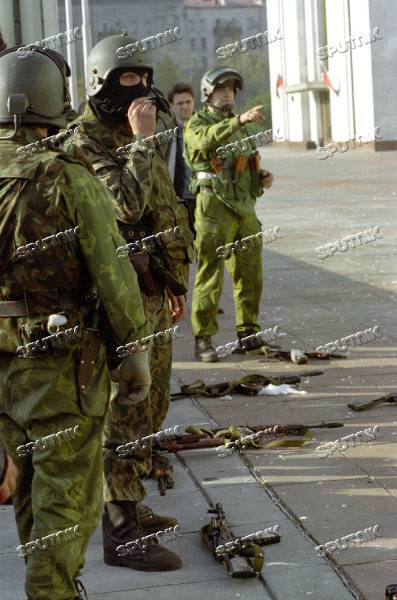
Employees of the "Vympel" and "Alpha", 4 October 1993 g. The fighter in the foreground can see the knife HP-43 in the sheath. Photo RIA News
The version of the Cherry linkage and the enterprise from Zlatoust originated on the basis of a single photograph of a knife with a stamp bearing the letters Zik 1943. Subsequently, similar products with stamps "IMZ 1945", similar to the designations of the Zlatoust weapons of a later release, appeared. Other similar knives with other symbols and marks also made themselves felt. However, gunsmiths expressed doubt about the possibility of producing such products during the Great Patriotic War.
The main reason for doubt was plastic handles. In the first half of the forties, the enterprise "Zeke" simply did not have the opportunity to produce such products. The NA-40 series knives were equipped with wooden handles and sheaths. Plastic of the neo-lekikorit type was used only with the release of premium and general cold steel. Bars of this material were brought from Novosibirsk in small quantities and then processed manually. Then they could not stamp the necessary plastic parts.
The researchers also failed to find any references to the HP-43 knife in the archives. At the same time, it is known that the Zlatoust instrumental complex at that time had serious problems with labor, because of which it could not even fulfill the set production tasks. So, in 1943, the plant was supposed to supply more than 1,3 million ON-40 knives, however, only 388 thousands were handed over. In such conditions, the adjustment of the production of a new model of weapons looked unreal. Thus, in 1943 a year or later, the HP-43 scout knife was not produced in Zlatoust.
Nevertheless, gunsmiths from Zlatoust still worked on the development of knives. In 1944, work was underway to create a new army knife. For a number of reasons, this development has not reached the series. Only a few dozen samples were made, after which work stopped. The further fate of the pre-production knives is unknown. Apparently, they did not remain idle, and found some use.
Known information says that the HP-43 knives could hardly go into the series at a specified time. The design and materials of the handle clearly indicate that these products appeared after the end of World War II. There is a version that can explain this feature of weapons, as well as to justify the presence of stamps of the forties.
According to this version, which has not yet received a valid confirmation, in the seventies or eighties, the stocks of blades for the NA-40 knives were stored at the Zlatoust plant. These products were sent to some other enterprises, where they were equipped with a straight crosspiece and a plastic handle. This explains the unusual features of the weapon. Specialists from Chrysostom, in turn, make some adjustments to this version. They argue that in the seventies "Zeke" could not have a stock of blades, especially with the stamps of military acceptance.
Blades for "Cherries" were probably taken from warehouses. The stored knives of ON-40 were sent for rework, where they lost their old wooden handles and regular sheaths, instead of which they made new products. After that, knives with plastic handles and leather sheath began to be supplied to various units of the armed forces and security forces.
The version of the appearance of the knives HP-43 not earlier than the seventies receives indirect confirmation in the form of the time of the appearance of the first mentions of such weapons. The earliest references to the Cherry knife refer to the war in Afghanistan, where it was widely used by fighters of different types of troops. Subsequently, this army knife was repeatedly seen during other events.
Despite the lack of complete and accurate information about the origin of the weapon and its history as a whole, the knife of the HP-43 scout “Cherry” is of great interest to the interested public. The answer to this was the emergence of many modern knife replicas produced by various enterprises. Modern "Cherries" are produced by both domestic and foreign (primarily Chinese) enterprises. Replicas differ from each other and from the original in the materials used, the shape and configuration of the individual parts, etc. As a result, there are differences in various characteristics.
One of the manufacturers of modern replicas of the "historical" knife is the Zlatoust arms factory. Consider the current version of "Cherry" on the example of its products. Zlatoust produces knives that look as close as possible to the original. At the same time, some measures were taken to change the classification of the product. New "Cherry" is not a cold weapon and belongs to the class of tourist knives.
Buyers are offered a knife with a blade of steel 40X10С2М (EI-107), the geometric parameters of which correspond to the original product. Blade hardness - 56-58 HRC. The handle is made of elastollan black or green. A characteristic feature of such a handle is softness with the ability to "adapt" to the user's hand. The knife is equipped with leather sheath with the possibility of suspension on the belt.
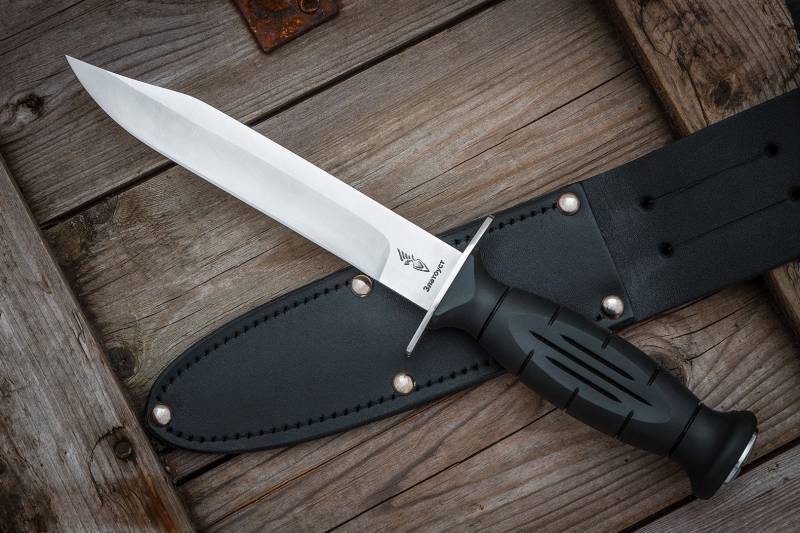
In addition to the brand "Zeke 1943" new products receive modern labels. Photo Zlatoust weapons factory / Zof.ru
Other manufacturers of knives and cold weapons produce products of similar configuration. Due to the numerous differences of modern replicas, it is possible to choose a product that most closely matches the views and desires of the customer regarding the color, shape of the blade, material, cost, etc.
Knife scout HP-43 "Cherry" is of great interest from a historical point of view. In addition, it is interesting for its fame in combination with other features. As it turned out, the well-known history of this product does not correspond to reality and, apparently, is a legend of a relatively recent appearance. At the same time, despite this, “Cherry” is widely known among professionals and amateurs, and also enjoys a certain popularity.
The history of the knife HP-43 looks different. However, this is not so important. The knife in the form of modern replicas is popular and is used in various fields, primarily as a household tool for one purpose or another. This fact indicates that the design of the knife "Cherry", which is a further development of the HA-40 product, has proven to be very successful and convenient to use. And if the tool is convenient and effective, then it does not matter when it appeared - in the forties or in the seventies.
Based on:
http://z-o-f.ru/
http://russianguns.ru/
http://holodnoe-oruzhie.ru/
http://green7-62.livejournal.com/
Maryanko A.A., Mak A.A. Army short blade of the 20th century: on the ground, in the heavens and at sea. - SPb .: “MAC”, 2007
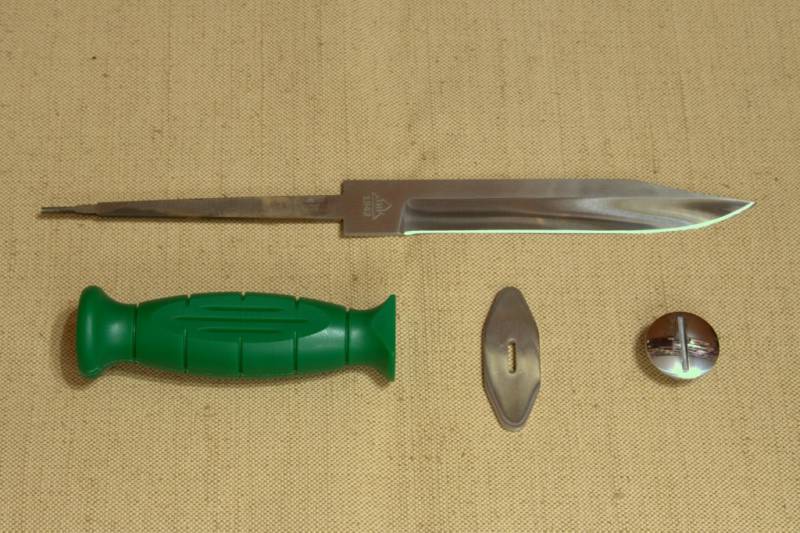
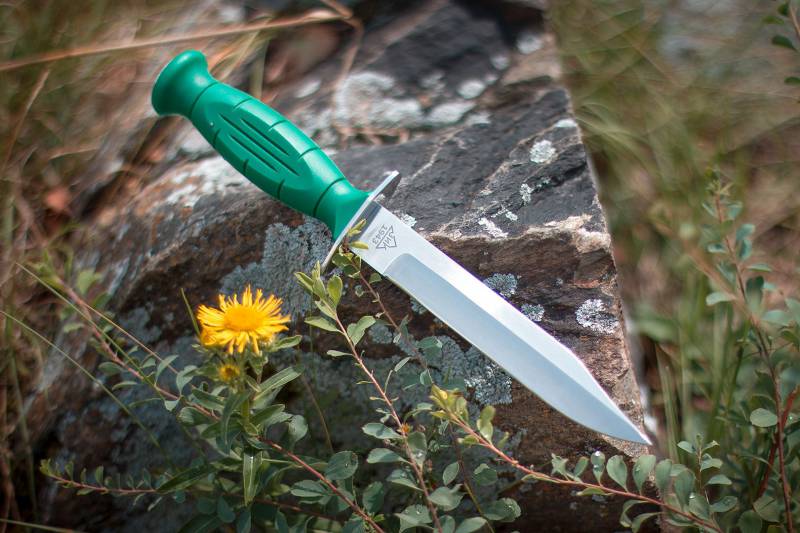
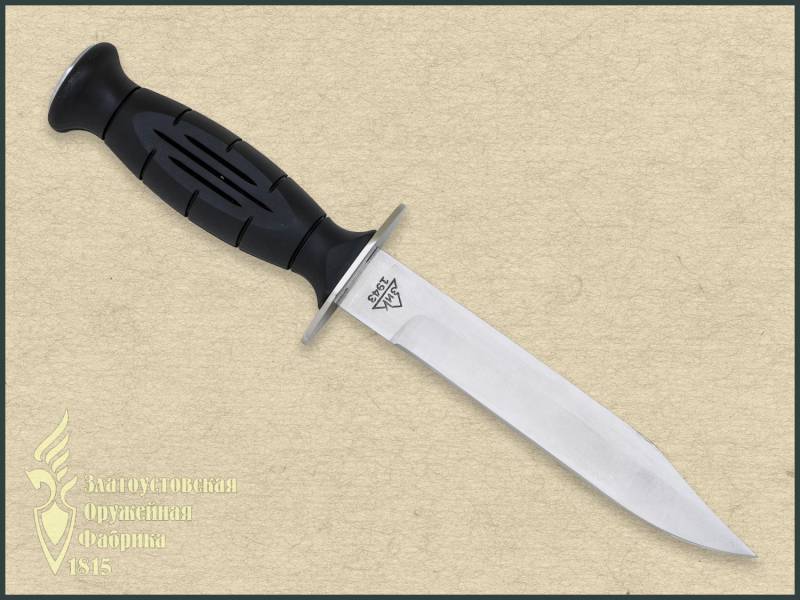
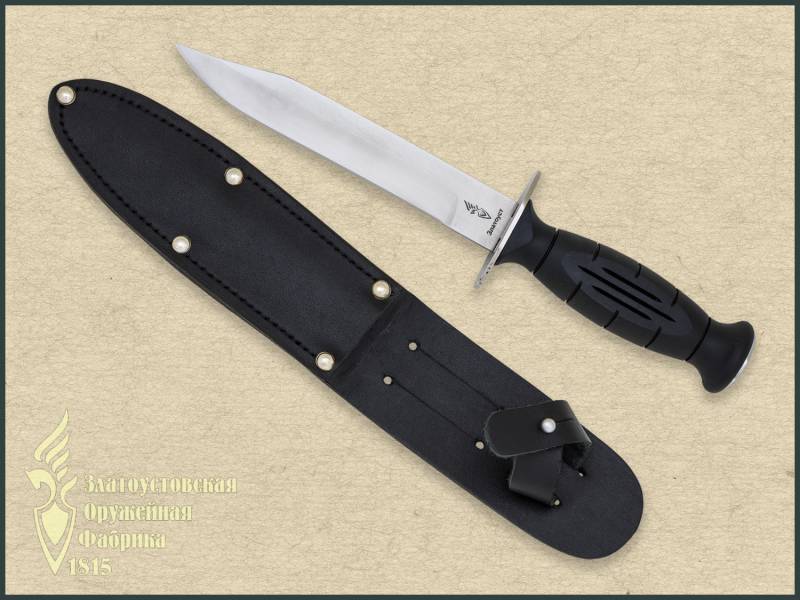
Information